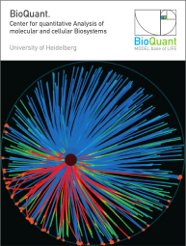Research Training Group: Mathematical Modeling for the Quantitative Biosciences (MMQB)
Regulation of gene expression: a non-equilibrium process: "Inference and mathematical modeling of gene-regulatory networks in hematopoietic stem cells" - BioQuant_Hoefer0116 [position filled]
Supervisior: Prof. Dr. Thomas Höfer (BioQuant & DKFZ)
Experimental partner: Prof. Dr. Michael Brunner (Biochemistry Center)
Background and scientific question:
Switching on (and off) the transcription of genes is a fundamental process of life. The traditional model for gene regulation considers the regulator proteins – so-called transcription factors –to serve as structural scaffolds for the recruitment of the multi-component transcription machinery to specific genes. This model can be phrased mathematically in terms of a well-understood theory from physics, equilibrium statistical mechanics. In this model, genes are transcribed continuously with a rate that ‘averages’ over the different configurations of bound transcription factors. However, recent experimental progress in probing gene regulation in living cells has yielded two key findings that cannot be reconciled with the equilibrium model. First, genes are not transcribed continuously but in brief bursts of messenger RNA (mRNA) production interspersed by long silent intervals. Second, many transcription factors in eukaryotic cells do not serve as (stably binding) structural scaffolds but as (transiently interacting) facilitators of enzymatic changes to the chromatin (the structure into which DNA is packaged in the cell nucleus), thus giving the transcription machinery access to a specific gene. These findings pose anew the question of how transcription factors regulate the rate of gene transcription.
Project goal:
In this project, we will develop non-equilibrium models of gene regulation driven by experimental data. We will do this in cooperation with the group of Michael Brunner, using a natural ‘optogenetic system’ in the fungus Neurospora crassa that allows us to synchronize gene transcription in a large population of cell nuclei by light (Cesbron et al., 2014).
Planned work and collaboration within the RTG:
We will combine deterministic and stochastic mathematical models, parameter estimation from data, model selection, and optimal control theory to address the following questions: (1) How do transcription factors act on the intrinsic stochastic bursting cycles of genes (potentially controlling burst frequency, amplitude or/and duration)? (2) Does the non-equilibrium regime overcome limits of sensitivity and speed of transcriptional regulation inherent in the equilibrium model? (3) How does stochastic transcriptional bursting allow the robust functioning of physiological control circuits, using the Neurospora circadian clock as a case study (Gin et al., 2013)? This project on gene regulation in eukaryotes is directly related to project of Ilka Bischofs, studying gene regulation in bacteria. Further interactions are envisaged as gene regulation is an integral part of the regulatory networks studied in the projects by Ursula Kummer and Niels Grabe; methodological exchange will take place with the Marciniak-Czochra and Schwarz groups.
List of relevant publications:
1. Cesbron F, Oehler M, Ha N, Sancar G, Brunner M (2015) Nature Commun. 6: 6753.
2. Coulon A, Chow CC, Singer RH, Larson DR (2013). Rev. Genet. 14(8): 572-84.
3. Gin E, Diernfellner ACR, Brunner M, and Höfer T (2013) Mol. Syst. Biol. 9: 667.
Application: If you would like to apply for one of these PhD research projects, please click here and follow the instructions on the HBIGS website.


